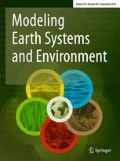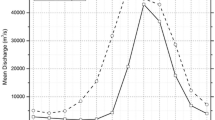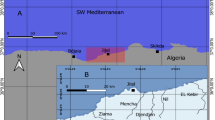Abstract
Remote-sensing techniques are a powerful technique for monitoring turbidity over the whole littoral areas. Different sensors can be used to quantify and analyze water quality parameters such as colored dissolved organic matter, total suspended sediments, chlorophyll-a, and pollutants. Therefore, the goal of this paper is to investigate the inter-annual and spatio-temporal variability’s of total suspended matter (TSM) concentration in the water surface layer. The coastal of the Atlantic Ocean, Morocco is taken an application area. The results show that high TSM (18 g m−3) is observed during winter season, and lower TSM (2 g m−3) is observed during summer season. In addition, the relationship between TSM and wind speed; and with ocean current was analyzed, and the results show that: (1) sand dredging areas usually coincide with region that have high TSM levels; (2) the wind and ocean current were both important to TSM variation; (3) the increased level of sand dredging in response to rapid economic growth has deeply influenced the TSM pattern since 2012 due to the resuspension of sediment in some areas. Visual interpretation of location led to the conclusion that the dredging activities were more located on the northern and western Morocco. Time series of MODIS images revealed a significant increase in water turbidity from 2012 onwards on the northern Morocco. Moreover, strong wind events in the northern Sahara can significantly increase the TSM in turbid coastal waters.











Similar content being viewed by others
References
Alaoui N, Mhammedi B, El Moumni A, El Hmaidi A, Raissouni A, El Arrim A (2008) Mineralogical and geochemical study of mud volcanoes in north Moroccan atlantic margin. Afr J Environ Sci Technol 2(11):387–396
Azidane H, Benmohammadi A, Haddout S, Hakkou M, Belghaba T, Boko M, Magrane B (2017) Evaluating the impacts of sea-level rise on the Moroccan coast: quantifying coastal erosion and inundation in a Atlantic alluvial plain (Kenitra coastal). Epis J Int Geosci 40(4):269–278
Bennasser L, Fekhaoui M, Jean-Louis Benoit-Guyod GM (1998) Influence of tide on water quality of lower Sebou polluted by Gharb plain wastes (Morocco).
Bouasria S, Sadki O, Hamoumi N (2007) Contamination in traces metals if superficial sediments at the exitoire of Tensift river-Souira Qdima (Moroccan Atlantic margin)
DPDPM (2007) Etude de reconnaissance géophysique des gisements de sable en vue de la protection des plages de l’Atlantique. Rapport définitif. Mission 1 : Etude d’identification des zones potentiellement exploitables, 176 p
DPDPM (2008) Etude de sédimentologie des ports et du littoral marocain. Mission 2 : identification des zones d’accumulations de sables et potentiellement exploitables. Rapport final, n°.17124436-M2R1, 92 p
DPDPM (2011a) Etude d’expertise sédimentologique de la plage de Mehdia. Rapport final, n°1712781, 81 p
DPDPM (2011b) Etude d’expertise sédimentologique de la plage de Mehdia (Maroc). Rapport final, n°1712781, 81 p
FAO (2014) The state of world fisheries and aquaculture, opportunities and challenges 2014. FAO Report, Rome
Gutierres F, Teodoro AC, Reis E, Neto C, Costa JC (2016) Remote sensing technologies for the assessment of marine and coastal ecosystems. In: Seafloor mapping along continental shelves, pp 69–104
Hakkou M, Benmohammadi A, Castelle B, Bertin X, Labraimi M, EL Hassani A, Layachi M (2015) Perspectives d’optimisation technique de la gouvernance environnementale des activités du dragage du sable marin au Maroc. Bulletin de l’Institut Scientifique, Rabat, Section Sciences de la Terre, n° 37
Huang P, Huang Y (2020) Spatial–temporal patterns of total suspended matters (TSM) in the Yellow River Estuary. In: IGARSS 2020–2020 IEEE international geoscience and remote sensing symposium, IEEE, pp 5773–5776
Jaaidi P, Cirac EB (1987) La couverture sédimentaire meuble du plateau continental atlantique marocain entre Larache et Agadir. Bulletin De L’lnstitut Géologique Du Bassin D’aquitaine 42:33–51
Mendes R, Vaz N, Fernández-Nóvoa D, da Silva JCB, de Castro M, Gómez-Gesteira M, Dias JM (2014) Observation of a turbid plume using MODIS imagery: the case of Douro estuary (Portugal). Remote Sens Environ 154:127–138. https://doi.org/10.1016/j.rse.2014.08.003
METL (2014) Ministère d’équipement, du Transport et de la logistique, M. Impact de la houle exceptionnelle du 6–7 janvier 2014 sur les infrastructures portuaires
Moussaid J, Ait A, Zourarah B, Maanan M (2015) Using automatic computation to analyze the rate of shoreline change on the Kenitra coast, Morocco. Ocean Eng 102:71–77. https://doi.org/10.1016/j.oceaneng.2015.04.044
NASA (2008) About Modis. Retrieved 16 Feb 2008. http://modis.gsfc.nasa.gov/about/.
Ritchie JC, Zimba PV, Everitt JH (2003) Remote sensing techniques to acess water quality. Photogramm Eng Remote Sens 69(6):695–704
Shen Q, Xing X, Yao Y, Wang M, Liu S, Li J, Zhang B (2021) Estimation of suspended matter concentration in manwan reservoir, lancang river using remotely sensed small satellite constellation for environment and disaster monitoring and forecasting (HJ-1A/1B), charge coupled device (CCD) data. Int J Remote Sens 42(14):5236–5256
Singh RK, Sinha VSP, Joshi PK, Kumar M (2021) A multinomial logistic model-based land use and land cover classification for the South Asian Association for Regional Cooperation nations using moderate resolution imaging spectroradiometer product. Environ Dev Sustain 23(4):6106–6127
Tang S, Larouche P, Niemi A, Michel C (2013) Regional algorithms for remote-sensing estimates of total suspended matter in the Beaufort Sea. Int J Remote Sens 34(19):6562–6576. https://doi.org/10.1080/01431161.2013.804222
Teodoro AC (2015) Applicability of data mining algorithms in the identification of beach features/patterns on high-resolution satellite data. J Appl Remote Sens 9(1):095095. https://doi.org/10.1117/1.JRS.9.095095
Teodoro AC, Gonçalves H (2012) A semi-automatic approach for the extraction of sandy bodies (Sand Spits) from IKONOS-2 data. IEEE J Sel Top Appl 5(2):634–642. https://doi.org/10.1109/JSTARS.2011.2181339
Vahtmäe E, Kutser T (2013) Classifying the Baltic Sea shallow water habitats using image-based and spectral library methods. Remote Sens 5(5):2451–2474. https://doi.org/10.3390/rs5052451
Vanhellemont Q, Ruddick K (2014) Turbid wakes associated with offshore wind turbines observed with Landsat 8. Remote Sens Environ 145:105–115
Wang Z, Li L, Chen D, Xu K, Wei T, Gao J, Zhao Y, Chen Z, W., & Masabate. (2007) Plume front and suspended sediment dispersal off the Yangtze (Changjiang) River mouth, China during non-flood season. Estuar Coast Shelf Sci 71(1–2):60–67
Yang M, Khan FA, Tian H, Liu Q (2021) Analysis of the monthly and spring-neap tidal variability of satellite chlorophyll-a and total suspended matter in a turbid coastal ocean using the DINEOF method. Remote Sens 2021(13):632
Zhu W, Tian YQ, Yu Q, Becker BL (2013) Using Hyperion imagery to monitor the spatial and temporal distribution of colored dissolved organic matter in estuarine and coastal regions. Remote Sens Environ 134:342–354. https://doi.org/10.1016/j.rse.2013.03.009
Acknowledgements
The authors gratefully acknowledge two anonymous reviewers for their scientific suggestions and constructive comments which led to significant improvements to the manuscript. The first author would like to thank the Centre of Excellence (CofE)-NF-POGO-Alfred Wegener Institute Helmholtz Centre for Polar and Marine Research (AWI)-Germany for various effort supporting this research.
Author information
Authors and Affiliations
Corresponding author
Ethics declarations
Conflict of interest
The authors declare that they have no known competing financial interests or personal relationships that could have appeared to influence the work reported in this paper.
Ethical approval
I confirm that this work is original and have not been published elsewhere, nor is it currently under consideration for publication elsewhere.
Additional information
Publisher's Note
Springer Nature remains neutral with regard to jurisdictional claims in published maps and institutional affiliations.
Rights and permissions
About this article
Cite this article
Azidane, H., Haddout, S., Alawad, K.A. et al. Mapping total suspended matter along Moroccan coast using satellite data series. Model. Earth Syst. Environ. 8, 1683–1692 (2022). https://doi.org/10.1007/s40808-021-01179-4
Received:
Accepted:
Published:
Issue Date:
DOI: https://doi.org/10.1007/s40808-021-01179-4




